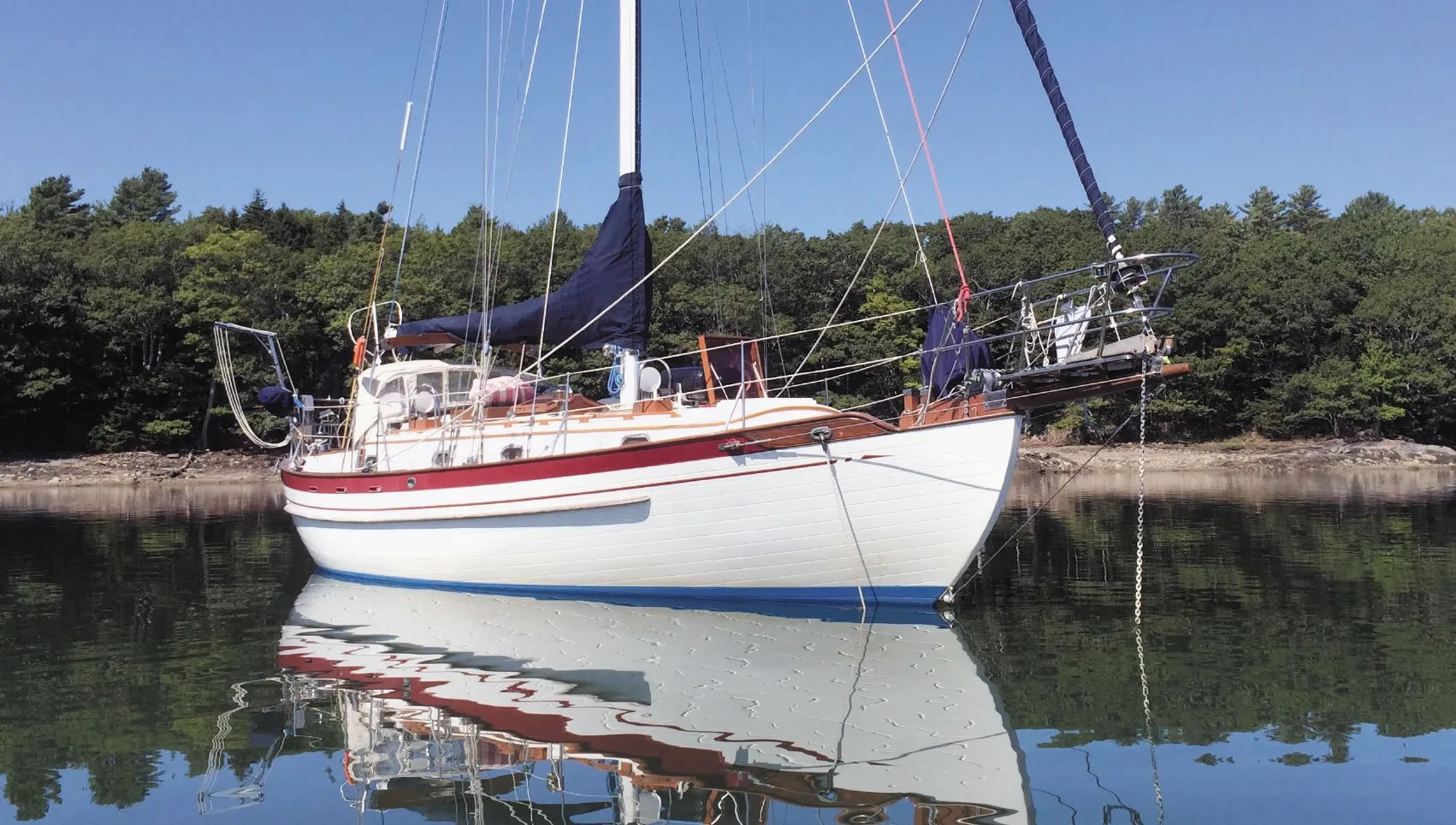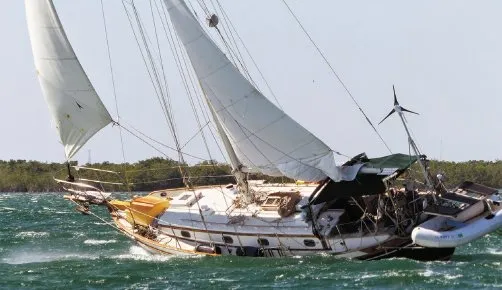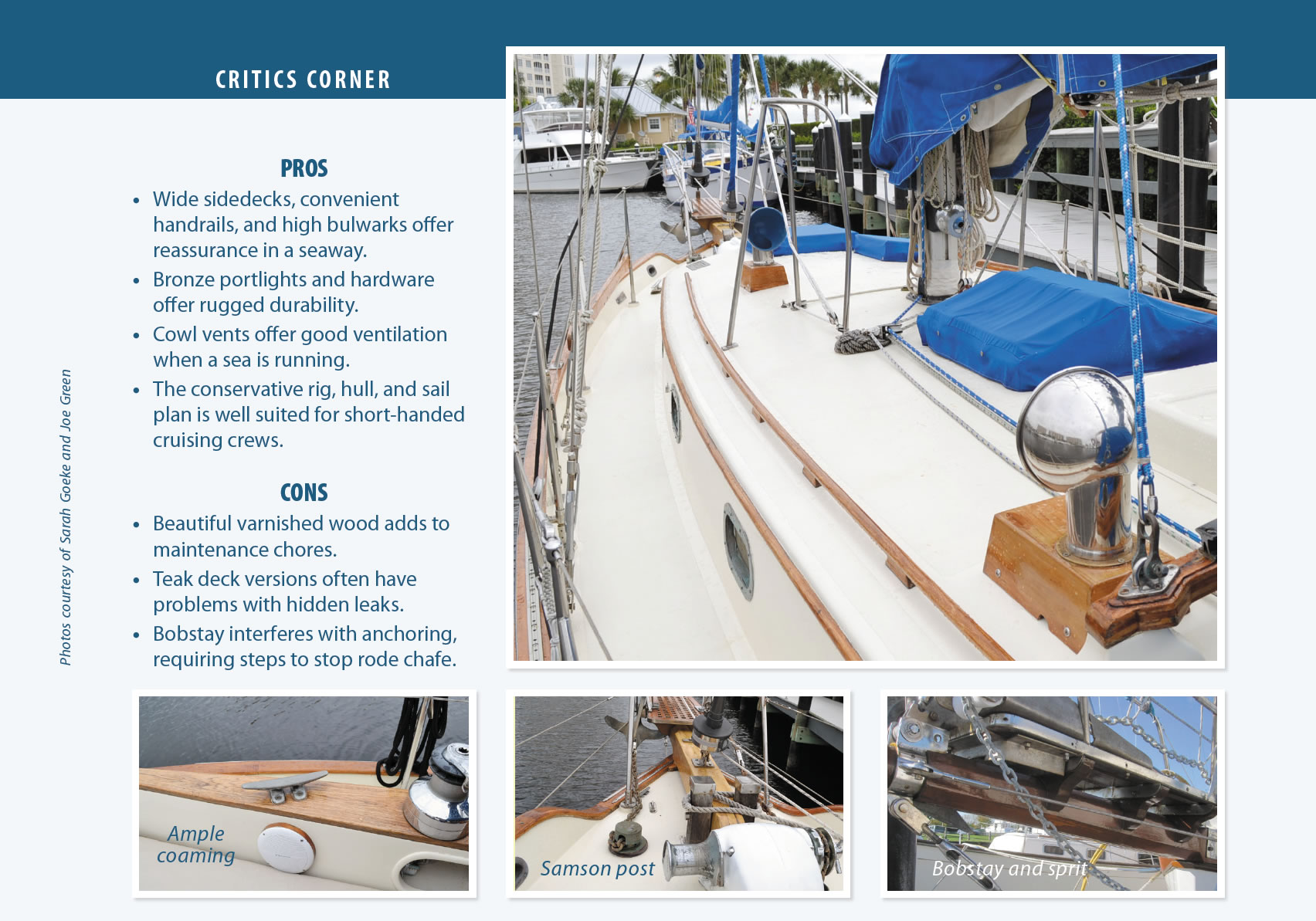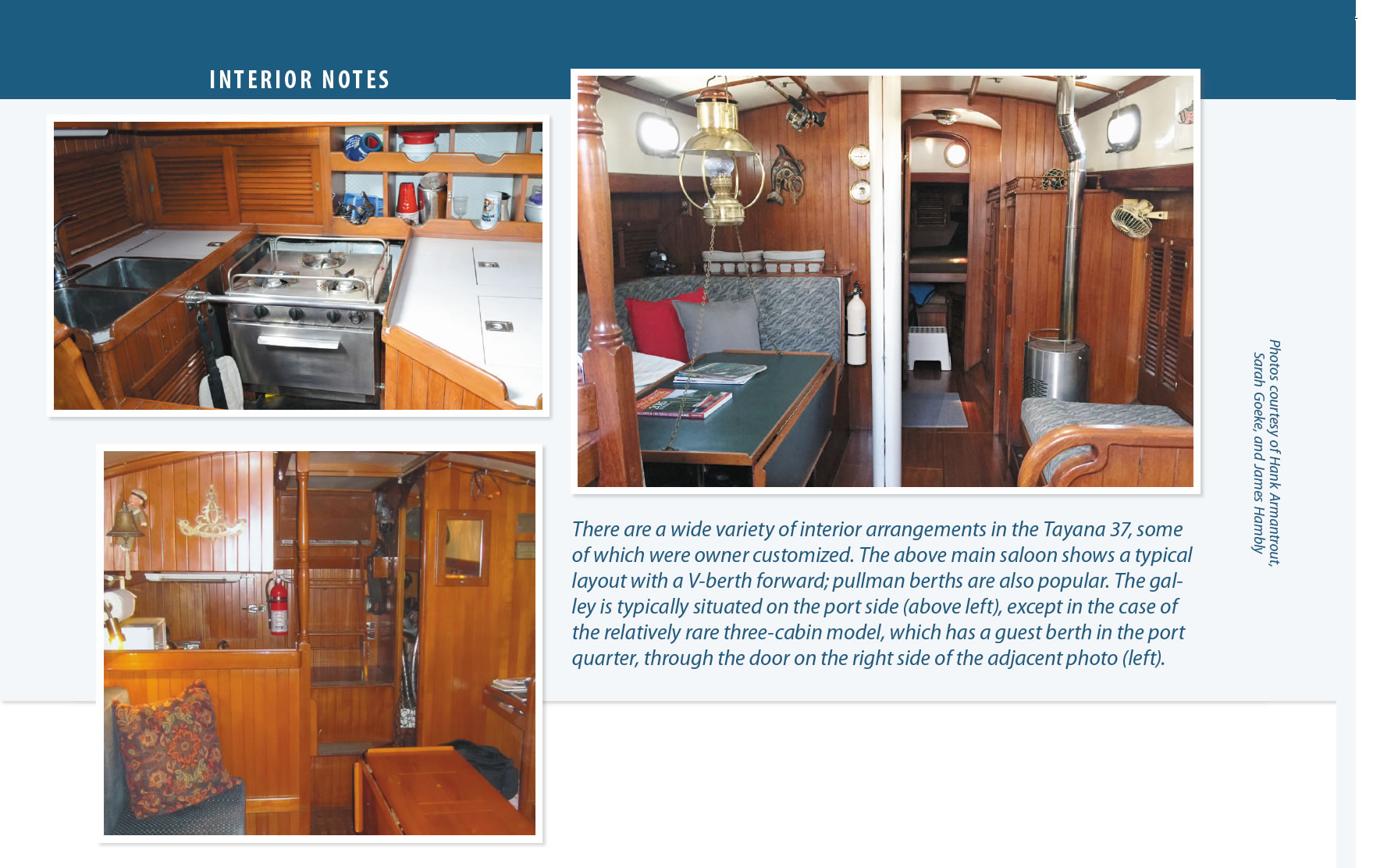With several hundred boats sailing the seas of the world, the Tayana 37 has been one of the most successful products of the U.S.s Taiwan-built boat invasion that began in the early 1970s. Its shapely Baltic stern, scribed plank seams molded into the glass hull, and lavish use of teak above and belowdecks have come to epitomize the image associated with Oriental boats.
Not all thoughts of Far Eastern boats are pleasant, however. To some, Taiwan-built boats mean poor workmanship, overly heavy hulls, unbedded hardware of dubious heritage, wooden spars that delaminate, and builder-modified boats lightyears removed from the plans provided by the designer. Add to that a serious language barrier and the inevitable logistical problems of dealing with a boatyard halfway around the world, and you have a readymade nightmare for the boat buyer. To the credit of the builder, the designer, the primary importer, and a powerful owners association, the Tayana 37 has weathered an astounding production run while making steady improvements and maintaining a steady output with about 600 boats in existence.

Washington-based boat designer Bob Perry had just hung out his own shingle when he designed Tayana 37 in the early 70s. The Sherman-tank Westsail 32 had just come lumbering onto the scene, bringing with it a resurgence of interest in the double-ended hull form, and more people than ever before were beginning to have the dream of chucking it all and sailing away to a tropical paradise.
Perry has become an enormously successful designer of cruising boats, from traditional, full-keel designs such as the Tayana 37 to modern, fin-keel cruisers such as the Nordic 40, GoldenWave 42, and the Valiant 40. A remarkable number of his designs have been built in the Orient, in both Hong Kong and Taiwan.
Perry conceived the Tayana 37 as a cruising boat of traditional appearance above the water, with moderately heavy displacement, a long waterline, and a reasonably efficient cutter rig of modern proportions. (A ketch rig was also available). Below the water, the forefoot of the long keel has been cut away, and a Constellation-type rudder was utilized rather than a more traditional barn door. Perry sought to cash in on the popularity of the double-ended hull while keeping displacement moderate and performance reasonable, avoiding the plight of boats such as the Westsail 32-the inability to go to windward and sluggish performance in anything short of a moderate gale. The stern design of the Tayana 37 borrows heavily from the well-known Aage Nielsen-designed ketch, the Holger Danske, winner of the 1980 Bermuda Race. It is one of the more handsome Baltic-type sterns on any production sailboat.
The Tayana 37 began life as the CT 37. In 1979, the boat became known as the Tayana 37, named for Ta Yang Yacht Building Co. While some snobbishness exists among owners who own the CT version, Perry has insisted that this is illusory. According to the designer, the CT 37 and the Tayana 37 are the same boat, built by the same men in the same yard. In much the same way that the early Swans imported by Palmer Johnson were known by the name of the importer-the names Nautor and Swan were unknown here in the late 1960s-early Tayanas were known as CTs because the name CT had already become known in this country.
Perry, who worked with many yards in the Far East, considers Ta Yang one of the best. The yard always was very responsive to input from both dealers and owners. Over the years, this resulted in steady improvement in the quality of the boat.

Handling Under Power
Three different engines have been used in the Tayana 37: the Yanmar 3QM30, the Perkins 4-108, and the Volvo MD17C. The latest change was to the Yanmar as standard propulsion. This makes good economic sense, as Japan is closer to Taiwan than either England or Sweden.
Although all of the engines offer adequate power for the boat, don’t expect the Tayana 37 to win any drag races. With her substantial wetted surface and fairly heavy displacement, performance under power is sedate rather than spritely. Owners rate handling under power as fair to good, although one reported that his boat backs up like a drunken elephant.
While the engine box removes completely to provide good access for service, there is no provision for easy access to the oil dipstick. This means that this vital task is likely to be ignored. A simple door in the side of the engine box would solve the problem.
The placement of the fuel tank also has caused substantial discussion on the part of owners. The standard 90-gallon, black iron tank is located under the V-berth in the forward cabin. When full, this tank holds almost 650 pounds of fuel. This is about the same weight as 375 feet of 3/8-inch anchor chain-a substantial amount to carry around in the bow of a 37-footer. A Tayana 37 with the bow tank full and a heavy load of ground tackle will show noticeable bow-down trim. The design was originally drawn with the fuel tanks under the settees, but the builder put the tank forward to create additional storage in the main cabin.
This is a good example of one of the basic recurring problems with Far East-built boats. Frequently, the builders have good glass men and good interior joiners, but their inexperience in sailing results in inconsistencies that compromise their boats. Fortunately, thanks to the pressure from owners, the builder began offering optional tankage amidships, where it belongs.
The Tayana 37 was built as a ketch or cutter, with wood spars or aluminum, with mast-stepped on deck or on the keel. Few builders have offered so many options. The standard rig is a masthead cutter with wooden spars; the mast is stepped on deck and supported by a substantial compression column. The designer strongly recommended the aluminum cutter rig, and we heartily concur. The wooden mast is poorly proportioned, with a massive section and extremely thick sidewalls. One mast we looked at had a large knot on the forward side of the mast just at spreader level. Despite the huge mast section, we feel the knot could weaken the mast significantly. In contrast to the large section of the mast, the boom was an extremely small spruce box section. With mid-boom sheeting, this spar will probably bend like a rubber band, complicating mainsail shape. The clew outhaul slide is far too flimsy for a boat of this size, and owners report that the outhaul slide frequently distorts or explodes. Once again, these problems are rather typical in Taiwan boats, where you frequently find excellent craftsmanship but a poor understanding of engineering or the forces involved in ocean sailing. In contrast, the aluminum rigs, which may come from a variety of sources including France, New Zealand, and the U.S., are well proportioned and suited to the task. We see no reason to select the ketch rig. Both performance and balance with the cutter rig will be better. The cutters mainsail is 342 square feet. Any couple healthy enough to go world cruising should be able to cope with a sail of this size. The cutter rig is tall and well proportioned. Perry has drawn an unusually high-aspect rig for a cruising boat, and the result is a boat with good performance on all points of sail. With the aluminum rig, the optional Nicro Fico ball-bearing mainsheet traveler and a well-cut suit of sails, the Tayana 37 will be surprisingly fast. Her working sail area of 864 square feet is generous. Despite a ballast/displacement ratio of 33 percent, the Tayana 37 is not a stiff boat. This is due in part to the tall, heavy rig and the substantial amount of other weight above the boats vertical center of gravity. Much of the boats heavy joinerwork and glasswork is well above the waterline, raising the center of gravity and reducing initial stability. Perry believes the initial tenderness to be an asset, reducing the snappiness of the boats roll and making her a more comfortable sea boat. We agree. Many owners report that the boat carries substantial weather helm. The sailplan is drawn with significant rake to the mast. This creates just enough shift in the center of effort of the sailplan to create a lot of weather helm. Bringing the mast back toward the vertical by tightening the headstay and forestay while loosening the backstay should cure much of the problem, according to reports from other owners. It may be necessary to shorten the headstay to do this. The weather helm and initial tenderness may also be due in part to the poor cut of the standard sails provided with the boat. Many of the boats in existence came with standard sails made by Lam of Hong Kong. These sails have the reputation of being stretchy and having very poor shape. Mainsail draft with this fabric is almost uncontrollable, with the sail becoming baggy and the draft moving aft as the wind increases. This will create weather helm and increase the angle of heel. With its bulwarks, high double lifelines, and substantial bow and stern pulpits, the Tayana 37 gives the sailor a good sense of security on those cold, windy nights when called out for sail changes. A teak platform grating atop the bowsprit coupled with the strong pulpit, relieves that appendage of its widowmaker reputation. The bowsprit platform incorporates double anchor rollers, which can house CQR anchors. Unfortunately, there is no good lead from the rollers to any place to secure the anchor rode. Line or chain led to the heavy bowsprit bitts would chafe on the platform. An anchor windlass mounted to port or starboard of the bowsprit would provide a good lead. There are hawseholes through the bulwarks port and starboard, well aft of the stem. These will be fine for docklines, but are too far aft to serve as good leads for anchoring. There is room at deck level, outboard of the bowsprit, to install a set of heavy chocks for anchoring, although anchor rode led to this point will chafe on the bobstay as the boat swings to her anchor. This is a classic problem of the boat with a bowsprit. The anchor rode must really lead well out the bowsprit to avoid the bobstay, yet the long lead complicates securing the inboard end of the rode. A common solution is a bridle led to the hawseholes. The long staysail boom makes it difficult to cross from one side of the boat to the other forward. The standard staysail traveler is merely a stainless-steel rod on which a block can slide on its shackle. Under load, this can bind when tacking, so that it may be necessary to go forward and kick the block over after every tack. By all means look for boats with the optional Nicro Fico travelers with their roller-bearing cars. Complaints about the standard travelers are rife. Standard winches on the boat were Barlow. We suggest that you try to find self-tailing winches for all sheets. Although the sidedecks are relatively narrow due to the wide cabin trunk, there is reasonable access fore and aft. A full-length handrail on either side of the cabin trunk provides a good handhold. The cockpit of the Tayana 37 is small, as befits an oceangoing sailboat. There are cockpit scuppers at each of the four corners of the cockpit well, with seacocks on the through-hull outlets. With the pedestal steering, the cockpit seems to have shrunk. Only three can be seated in real comfort, although this is no real problem for the cruising couple. It is not a cockpit for heavy entertaining in port. The elimination of the coaming around the stern of the boat has made the cockpit seats long enough for sleeping on deck, but at the expense of exposing the helmsman to a wet seat in a following sea. Cockpit locker configuration varies with the interior options chosen, but the lockers are large enough to provide reasonable storage, although you should resist the temptation to load them heavily so far aft. The interior of the Tayana 37 probably sells more boats than any other feature of the boat. Every boat was custom built so there has never been a standard interior. Like other Taiwanese boats, the interior of the Tayana 37 is all teak. This can result in a cabin that is oppressively dark to some people, and exquisitely cool to others. To keep it looking good, owners must do a lot of oiling or varnishing. The interior joinerwork on the boat we examined was some of the best we have seen. Joints were just about flawless, paneled doors beautifully joined, drawers dovetailed from solid stock. There were no fillers making up for poorly fitted joints, no trim fitted with grinders, no slop anywhere. Older Tayana 37s (70s-80s vintage) we have seen did not boast quite this caliber of workmanship, but their joinerwork was certainly of good quality. With such an array of interior options, it is difficult to really evaluate the boats interior. Although, in all fairness, there is a standard interior. It is prosaic but good, with a V-berth forward, followed by the head and lockers just aft. The main cabin has a U-shaped settee to port, straight settee and pilot berth to starboard. Aft is a good U -shaped galley to port, nav station and quarterberth to starboard. The Tayana 37 is both typical and atypical of Taiwanese boats. It is typical in the problems that existed due to the builders inexperience with seagoing yachts, common with communication and language problems. It is atypical in that many of these problems have been solved over its many years of production. Anyone considering a Tayana 37 should join the owners association and read all the back newsletters before buying the boat. The total cost of a well-equipped Tayana 37 with most of the desirable options compares very favorably with other boats of her size, type, and displacement. The Tayana 37 would make an excellent retirement cruiser for the experienced sailing couple. Properly handled and equipped, she could take you anywhere with confidence and reasonable dispatch. Editors note: This review is an updated and expanded version of one previously published.
Sailboat Specifications Courtesy of Sailboatdata.com
Hull Type: Long Keel
Rigging Type: Cutter
LOA: 36.67 ft / 11.18 m
LWL: 31.00 ft / 9.45 m
S.A. (reported): 861.00 ft² / 79.99 m²
Beam: 11.50 ft / 3.51 m
Displacement: 22,500.00 lb / 10,206 kg
Ballast: 8,000.00 lb / 3,629 kg
Max Draft: 5.67 ft / 1.73 m
Construction: FG
First Built: 1976
# Built: 588
Builder: Ta Yang Yacht Building Co. (TAIWAN)
Designer: Robert Perry
Type: Diesel
HP: 40
Fuel: 90 gals / 341 L
Water: 100 gals / 379 L
S.A. / Displ.: 17.35
Bal. / Displ.: 35.56
Disp: / Len: 337.17
Comfort Ratio: 41.11
Capsize Screening Formula: 1.63
S#: 1.49
Hull Speed: 7.46 kn
Pounds/Inch Immersion: 1,273.81 pounds/inch
I: 50.80 ft / 15.48 m
J: 19.50 ft / 5.94 m
P: 45.30 ft / 13.81 m
E: 15.50 ft / 4.72 m
S.A. Fore: 495.30 ft² / 46.01 m²
S.A. Main: 351.08 ft² / 32.62 m²
S.A. Total (100% Fore + Main Triangles): 846.38 ft² / 78.63 m²
S.A./Displ. (calc.): 17.06
Est. Forestay Length: 54.41 ft / 16.58 m
Handling Under Sail
Deck Layout



Belowdecks


Conclusions

Market Scan Contact
1978 Tayana 37 Rubicon Yachts
$75,000 USD 510-737-0476
Berkeley, California Yacht World
1984 Tayana 37 United Yacht Sales
$54,900 USD 772-463-3131
Palm Coast, Florida Yacht World
1985 ayana 37 Admiral Yacht Sales
$52,900 USD 904-601-1342
Daytona Beach, Florida Yacht World









































The word “cost” without a number associated with it is just meaningless drivel. So how much would a “well-equipped Tayana 37 with most of the desirable options” cost? Ballpark, of course.
They run about $50K to 80K, depending more on condition, and whether or not they have been recently re-powered, than what year built.
A Baltic stern makes it impossible to have davits for the inflatable and difficult to have solar panels, and therefore is not wise for most cruising. Passage-making is another matter.
The excessive weather helm problem of the Tayana 37 has more to do with the mast position than anything else. The Tayang builders chose to place the mast 1′ farther aft than Bob Perry’s designs called for. Their reason was for larger accommodations in the forward cabin, namely dry lockers for hanging clothes and bedding, plus generous sized clothes drawers, and depending upon the floor plan, the addition of a private doorway entry into the head. And, as Darrell Nicholson points out, Tayang’s interior choices should not have been a greater priority than sailing characteristics. However, Tayana owners who have shortened the foot of the main & boom by 16″ to 18″ report that this has cured the weather helm problem without any noticeable loss of speed.
And, the point is well taken in regard to the nuisance and potential danger of the staysail boom. It’s really not an essential item and after removing it the sheeting can be configured in different ways to get good use out of the staysail.